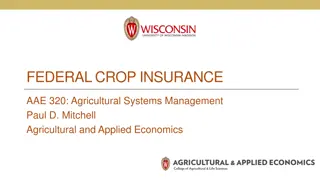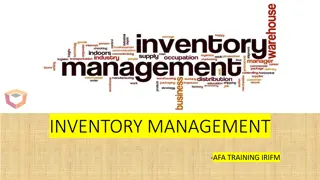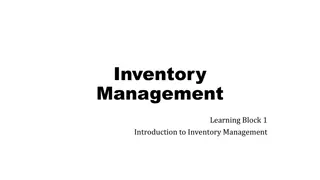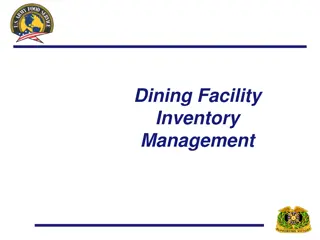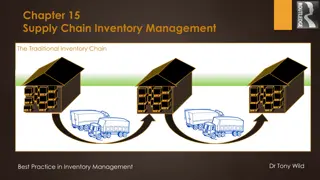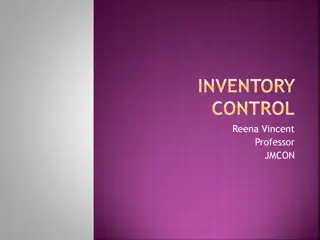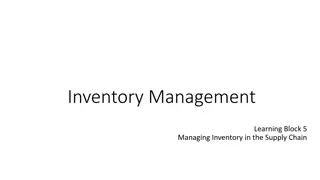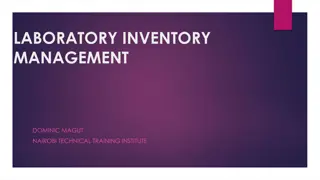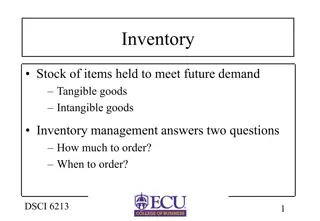Insurance and Inventory Management Lecture Insights
Explore the fundamentals of insurance with a focus on risk management and insurance policies, premiums, and a brief history of federal crop insurance. Discover how insurance plays a crucial role in mitigating losses and protecting businesses from various risks, including low yields, natural disasters, and revenue fluctuations in agriculture. Gain insights into the mechanisms behind calculating insurance premiums and the evolution of crop insurance in the United States.
Download Presentation

Please find below an Image/Link to download the presentation.
The content on the website is provided AS IS for your information and personal use only. It may not be sold, licensed, or shared on other websites without obtaining consent from the author.If you encounter any issues during the download, it is possible that the publisher has removed the file from their server.
You are allowed to download the files provided on this website for personal or commercial use, subject to the condition that they are used lawfully. All files are the property of their respective owners.
The content on the website is provided AS IS for your information and personal use only. It may not be sold, licensed, or shared on other websites without obtaining consent from the author.
E N D
Presentation Transcript
Insurance and Inventory Management Lecture 23 Lecture 23 Inventory Management.xlsx Lecture 23 Insurance.xlsx
Principal of Insurance Insurance is a risk management tool Buy insurance to cover a specific risk of a loss to the business Low yield due to fire, hail, drought, flood, etc. Low prices Low revenue due to low yield or price Health, auto, and home insurance most popular Liability insurance Insurance transfers a part of the risk to a third party for a fee
Terms for an Insurance Policy States the risk to protect against Conditions for a loss Amount of loss that must occur for a payment States the premium to be paid States indemnity payment conditions Amount of the deductible (losses not paid) Formula for calculating a payment
Insurance Premiums Premiums are set to cover the expected loss plus a risk premium (RP) and a profit for the insurance company Premium = Expected($Lose) + RP + Profit Calculate the Expected($Lose) w/ simulation Simulate the type of losses and use the losses in the formula for calculating the premium Calculate the average loss over a given time period, usually a year for the group Profit is a set fraction (e.g., 20%) RP covers risk not fully captured in PDF for risk
Brief History of Federal Crop Insurance 1930 s USDA offered yield insurance in the Great Plains for wheat Experimental project Expanded to other crops gradually 1971 Farm program offered Disaster Program Paid farmers for low yield and prevented plantings; no premium was charged Replaced with FCIC insurance in 1983 In 83 FCIC yield insurance expanded to all crops in all counties Congress eliminated the Low Yield Disaster Prog.
Insurance for Agriculture Crop Yield multi-peril insurance Low yields insured against hail, fire, insects, drought, flood Revenue insurance Protects crop farmers from low revenues relative to their historical average revenue The federal government through the USDA FCIC (federal crop insurance corporation -- Risk Management Agency) provides crop and revenue coverage policies for most crops and pasture
Agriculture Insurance Presents Unique Problems Agricultural risks widespread due to weather affecting large regions when drought occurs If a private insurance company covered all the risk they would be wiped out Solution was for the federal government to back up these companies USDA-Risk Management Agency (RMA) writes insurance policies and sets premiums and terms Private companies sell these policies Re-sell most of the policies to RMA Keeps the lower risk policies as an investment
Agriculture Insurance Industry Very large (international) reinsurance companies, such as: Zurich Insurance Group AG Bermuda based Aspen Insurance Holdings Ltd. Next layer of insurance companies actually have a sales force that sells insurance policies Farmers Mutual Hail Insurance Co., Rain and Hail, AgriLogic, ARMtech Insurance Cargill, John Deere, Wells Fargo recently exited the business Local insurance agents who meet with farmers All companies belong to NCIS
Some of the Major Crop Insurance Companies
Agriculture Insurance Industry USDA-Risk Management Agency (RMA) is the reinsurance agent Insurance companies sell the policies that RMA develops as well as their own RMA will buy back the policies that it develops so the insurance companies do not have to cover all of the losses Insurance companies face a portfolio problem: Policies sold to RMA only earn a % of the premium Policies they retain earn 100% of the premium if there is no indemnity, there in lies the risk of which policies to sell to RMA
Compare Conditions for Two years September 13, 2011 February 3, 2015 but parts of Texas are still in an exceptional, multi-year drought
FCIC Yield Insurance (YP) Production guarantee = APH * coverage level percentage elected APH = 10 year yield history on the farm unit Based on actual yields for the farm unit Farm unit can be a field or all fields (enterprise option) Premium set by RMA based on announced price guarantee, APH, county, and coverage level percentage Indemnity = Max[0, (Production Guarantee - Actual Yield)] * (Announced Price * Acreage Covered)
FCIC Yield Insurance 50 acres of corn, RMA projected/announced price of $3.50/bu, APH yield 145 bu/acre, 85% coverage level Production guarantee = 0.85 * 145 = 123.3 If actual yield is stochastic = 115 so lost yield = 123.3-115 Indemnity = (123.3-115) * 3.50 * 50
Revenue Insurance Crop Revenue Coverage (CRC) Producers buy a fraction of historical revenue Insured Revenue = APH * Announced Price * Fraction Revenue fractions are: 50% to 85% in 5% deltas Insure with a projected price or the harvest price based on the futures contract Indemnity = Max[0, (Guaranteed Revenue Actual Revenue) * Acres ] Actual Revenue = actual yield * (RMA projected price OR harvest time price)
Revenue Insurance 50 acres of corn, RMA projected price of $3.50/bu, APH yield 145 bu/acre, 85% coverage level Revenue guarantee = 50 * 145 * 0.85 * 3.50 Actual yield is stochastic = 100 Indemnity = Max[0, (revenue guarantee 50 * 100 * {3.50 or actual harvest time price})] Electing the RMA projected price is referred to Harvest Price Exclusion and is cheaper because the harvest price is generally lower
Analyzing & Picking Best Insurance Option This is a simple simulation problem Simulate yield and price based on history Compare yield or revenue to alternative (insured) coverage levels, calculate indemnities and premiums Pay premiums every year Collect indemnities only when there is a loss Pick insurance policy which is best at reducing risk and increasing net income, NPV, or cash flows
RMA Insurance Policies General Policies and Provisions Insurance policies must be purchased prior to planting to reduce: Moral hazard -- buying insurance when farmers know the crop will fail xxx Actual Revenue History (ARH) Pilot Endorsement (14-arh). Area Risk Protection Insurance (14-ARPI) Commodity Exchange Price Provisions (CEPP) Catastrophic Risk Protection Footnote 5. Ineligibility Amendment (15-Ineligibility) Footnote 1. Farm Bill Amendment (15-ARPI-Farm-Bill) Footnote 6. Catastrophic Risk Protection Endorsement (15-cat). Footnote 3. Common Crop Insurance Policy, Basic Provisions (11-br) Commodity Exchange Price Provisions (CEPP) Contract Price Addendum (CPA) Ineligibility Amendment (15-Ineligibility) Footnote 1. Farm Bill Amendment (15-CCIP-Farm-Bill) Footnote 2. Other Information Supplemental Coverage Option (SCO-15) High-Risk Alternate Coverage Endorsement (HR-ACE)(13-HR-ACE) High-Risk Alternate Coverage Endorsement Standards Handbook High-Risk Alternate Coverage Endorsement Frequently Asked Questions Livestock Quarantine Endorsement Pilot (11-qe). Rainfall and Vegetation Indices Pilot Whole-Farm Revenue Protection (WFRP) Pilot Policy
Insurance and Farm Policy 2014 Farm Bill is relying more on insurance and less on direct or indirect subsidies Supplemental Crop Option (SCO) STAX insurance for cotton lint The 2018 farm bill could change the insurance options and premium subsidies So far the announcements are no change in insurance from the House The Senate is yet to speak up
Insurance Job Opportunities Sales representative for the large companies Insurance actuary and analysts Insurance adjusters Seasonal employment that pays well Work during growing season only Visit damaged fields and prepare estimates of the damages Experience with crop production and economics Insurance companies complain there never enough adjusters
Insurance Use in Texas for Cotton 0.5 0.55 0.6 0.65 0.7 0.75 0.8 0.85 410,813 138,146 2,384,361 2,035,135 4,472,480 9,831,329 508,302 15,533 Acres of Cotton Participating in Crop Insurance in TX by Coverage Level 12,000,000 10,000,000 240 650 8,000,000 23249 4146 113 6,000,000 4,000,000 14 465 105 2,000,000 4 - 170 387 44 0.5 0.55 0.6 0.65 0.7 0.75 0.8 0.85
Insurance Use in Texas for Corn 0.5 0.55 0.6 0.65 0.7 0.75 0.8 0.85 147,477 Acres of Corn Participating in Crop Insurance in TX by Coverage Level 17,136 210,009 304,214 716,190 1,035,911 200,897 52,649 1,200,000 1,000,000 800,000 600,000 400,000 200,000 SUM - 0.5 0.55 0.6 0.65 0.7 0.75 0.8 0.85
Simulating a Learning Curve to Represent the Demand Cycle A new business may need a few months or years to grow sales to their potential May take months or years to learn how to reach potential for a production function In either case, assume a stochastic growth function and simulate it, if nothing else is available, use a Uniform distribution Example of a growth function for 8 years
Learning Curve or Demand Cycle Fan Graph for Realized Sales over 10 Years 250,000 200,000 150,000 100,000 50,000 - Sales1 Sales3 Sales5 5th Percentile 95th Percentile Sales7 Sales9 25th Percentile Average 75th Percentile
Life Cycle Costing A new concept in project feasibility analysis Explicitly consider externalities Such as cleanup costs at the end of the business Strip mining reclamation Removal of underground fuel tanks Removal of above ground assets Restoration of site Prevention of future environmental hazards Removal of waste materials 100 year liners for ponds
Life Cycle Costing Steps to Life Cycle Costing Analysis Identify the potential externalities Determine costs of these externalities Assign probabilities to the chance of experiencing each potential cost Assume distributions with GRKS or Bernoulli Simulate costs given the probabilities Incorporate costs of cleanup and prevention into the project feasibility These terminal costs may have big Black Swans so prepare the investor
Life Cycle Costing Bottom line is that LCC will increase the costs of a project and reduce its feasibility Affects the downside risk on returns Does nothing to increase the positive returns Need to consider the FULL costs of a proposed project to make the correct decision J. Emblemsvag Life Cycle-Costing: Using Activity-Based Costing and Monte Carlo Simulation to manage Future Costs and RisksJohn Wiley & Sons Inc. 2003
Life Cycle Analysis LCA is a tool for determining the impact of a new process or project on the environment and climate change LCAs are concerned with quantifying Energy Use and CO2 Balance Green House Gases (GHGs) Water use and indirect Land use Nutrient (N,P,K) use and other factors Thus far these are deterministic analyses This will soon change
Life Cycle Analysis For those interested in a good example of LCA see MS thesis in our Department by Chris Rutland Analyzed the carbon footprint for crop and dairy farms in principal production regions in the US GREET Model developed by Dept. of Energy engineers at Argonne National Labs Download it and use it for free Contains NO risk variables
Inventory Management Inventory management is about When to re-order How much to order Factors to consider Cost of storage Cost of placing an order Cost of lost sales due to shortage Stochastic demand Delivery time from time order is placed Can you backlog demand
Inventory Management Simulate the inventory management problem as a stochastic problem Simulate N periods to test impacts of alternative inventory management schemes Period -- length of time for the problem week, month Based on the time period for the demand data Also based on order/delivery time
Inventory Management Example of a weekly Inv. Management Problem Cost to place an order $200 Cost of a unit purchased $4 Cost of storage for 1 week $3 Cost of each lost sale $10 Price of product sold $25 Weekly demand PDF ~ N(40,6) 2 week delivery time; could be stochastic Beginning inventory 100 Inventory management rule to test: Place order if inventory on hand <= 50 units Amount to order = 150 minus the inventory on hand KOV = average weekly profit, cost, inventory, revenue
Rules for Simulating Inventory Demandt is stochastic Beginning inventoryt = ending inventoryt-1 Supplyt = beginning inventoryt + quantity receivedt Salest = Minimum (demandt or supplyt) Ending Inventoryt = supplyt salest Quantity receivedt = quantity orderedt-n if it takes n periods for the delivery Could have a stochastic under shipment factor Lost salest = 0.0 If(supplyt > demandt) else Lost salest = demandt supplyt
Calculating Inventory Costs Purchase costst = cost per unit paid for product Order costst = fixed cost to place an order (shipping costs, office expense, delivery processing costs, Fed Ex rush delivery fee, etc.) Storage costst = cost per unit * beginning inventoryt Penalty costst = cost to the business for lost sales or lost salest * cost for perceived lost goodwill
Inventory Management Model Week Beginning inventory Quantity Ordered Quantity Received Supply Demand Sales Ending Inventory Lost Sales 1 2 3 0 4 0 100 60 0 0 0 0 150 150 150 150 50 50 100 0 0 100 40 40 60 60 70 60 30 0 0 0 0 10 30 0 Costs Storage Order Purchase Penalty TOTAL 300 180 0 0 0 0 0 0 0 200 600 300 1100 200 600 100 280 0 300 800 Revenue Profit 900 600 1350 1070 0 1125 325 -1100 The model should have 40 to 50 weeks so the startup conditions do not dictate the results for the inventory management rule being analyzed
Inventory Management Scenarios Test alternative reorder points Should firm reorder when inventory < 50? Scenarios: 40, 50, 60, 70, 80, 90 for the reorder point Order up to some amount Should firm reorder a larger amount Scenarios: 140, 150, 160, 170, 190, or more Would it be more profitable to pay more (or less) to get the order delivered faster (slower)? Pay $300/order to get delivery in 1 week Pay $100/order to get delivery in 3 weeks The profit PDF changes for each question; use simulation to estimate the profit PDF for each scenario
Inventory Management.XLS Scenario reorder points of: 50, 60, 70, 80, 90 Stochastic Efficiency with Respect to A Function (SERF) Under a Power Utility Function 380 370 Profit: 2 360 Profit: 3 Profit: 1 350 340 330 Profit: 4 320 Profit: 5 310 0 0.00001 0.00002 0.00003 0.00004 0.00005 RRAC Profit: 1 Profit: 2 Profit: 3 Profit: 4 Profit: 5










